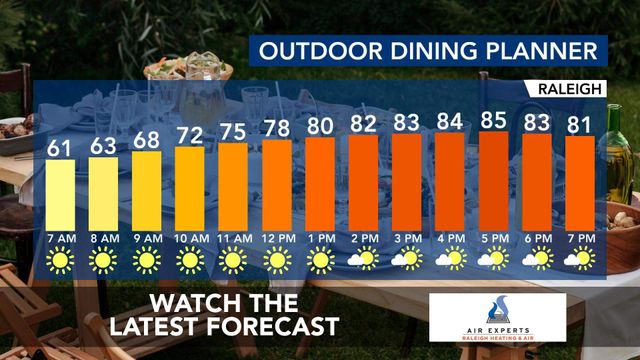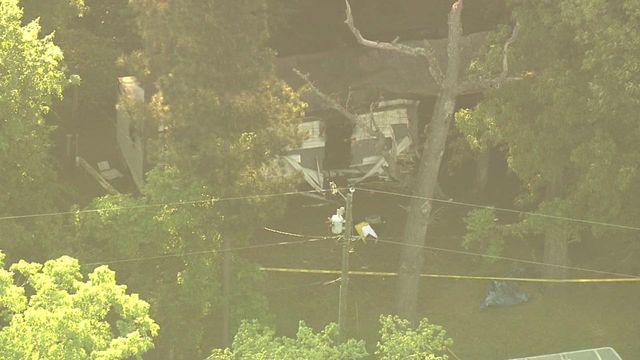Virtual teachers beam into NC to give short-staffed schools some classroom consistency

Eighth-grade English students at Northern Granville Middle School are just like others across the state. They work on sentence structure and learn how to analyze ideas. They whisper to their classmates.
But unlike their peers in most other schools, their teacher isn’t in the classroom, let alone Granville County. Instead, they’re on a webcam, beamed into the room via computer from far-flung places.
These virtual teachers are Granville County Schools’ $1-million solution to a nationwide hiring problem in K-12 education, giving students in unstaffed classes some consistency — instead of a revolving door of substitutes.
“At first our parents were a little apprehensive,” said Blondina Small, principal of the Oxford school, which has virtual teachers in 10 sixth- through eighth-grade English language arts classes. “But once they saw that the teachers were certified and highly qualified, and they could see that they were building relationships with the students and the students were progressing, they became more comfortable.”
As school systems across the country grapple with teacher shortages, this new type of teacher is increasingly entering classrooms on camera, speaking through a microphone and often hundreds of miles away from the children they’re teaching.
Virtual teachers are in at least 16 school systems and several charter schools spanning the state.
Virtual education companies, which employ the teachers, market themselves as solutions to ongoing shortages of teachers, especially in perpetually difficult-to-fill roles teaching math and science.
Virtual teachers ensure a class has a trained instructor leading it, but they’re not exactly schools’ first choice. Schools want to hire people who will live in their communities and be able to physically interact in their schools.
Lacking in-person educators, schools are finding virtual teachers to be the best alternative.
They generally work like this: The virtual teacher and their lessons are projected at the front of a physical classroom. All students must still attend in-person to be present. The teacher provides a virtual classroom and tools to access lessons and coursework online at any time. And the teacher can talk to students and occasionally hear them. Communication often takes place in classroom chats or private chats with individual students.
The physical classrooms, meanwhile, are often staffed with a “coach” to ensure students are doing their work and behaving, as well as providing other academic support that may be needed.
The virtual teachers at Northern Granville Middle are trained in their subject areas, which is vital, Small said. “It’s a huge advantage for the children to have instruction from highly qualified teachers,” she said. “And with the teacher shortages, it gives them that opportunity they don’t have with a long-term substitute. They have someone who knows the content, who works with the students, the classroom coaches and the parents.”

The concept has gained steam — and perhaps acceptance and scrutiny — in the post-pandemic world of public education. Months of remote learning during the Covid-19 pandemic resulted in universal declines in test scores and slowed paces of learning. For some students, remote learning was hand-delivered paper packets of texts and worksheets but for many more, it was a laptop, a virtual teacher and a bedroom devoid of any classmates.
Also declining in recent years: The number of qualified teachers in North Carolina and beyond.
That has buoyed a burgeoning industry seeking to solve the shortage.
Granville County Schools is spending more than $1 million on virtual teachers this year through a contract with Elevate K-12, one of the largest providers of virtual teachers in the country.
Another company, Proximity Learning, also works in North Carolina schools.
But not every school can do it. At most public schools, permanent teachers must have a North Carolina teaching license. But charter schools and certain lower-performing schools, such as Northern Granville Middle, can have flexibility in whom they hire to teach children.
Filling empty positions
Companies that provide virtual teachers are growing, with venture capital investment and school contracts.
The trend of virtual teachers doesn’t foretell a new kind of school yet, but rather a new kind of solution for a problem that’s always been around and has worsened in recent years. Schools have long experienced difficulty filling teacher positions for certain types of classes, such as science, math and special education. And a waning interest in education as a major for college students, who are facing an increasingly debt-ridden experience, means fewer people are in line to replace educators who are retiring.
North Carolina school systems — excluding charter schools — reported at least 3,584 teacher vacancies to start the school year, according to North Carolina School Superintendents Association Executive Director Jack Hoke.
“I just don’t remember the vacancies,” Hoke, a former superintendent, said. “It certainly didn’t seem pre-pandemic that we were talking about this.”
Public education vacancies have steadily risen nationally over the past two decades, according to the U.S. Bureau of Labor Statistics. Since the mid-2000s the number of unfilled jobs is up from consistently less than 1% at any given time to about 3% nowadays.
And while that’s less than almost every other major public and private sector industry, bureau data show, vacancies are perhaps more noticeable in schools. When a classroom doesn’t have a teacher, a school needs to find someone else to be that teacher, for a day or a week or even longer.
Research shows students perform better academically when they’ve had a permanent teacher for the whole school year instead of multiple teachers, such as multiple long-term substitutes.
Hiring teachers virtually more closely aligns the education sphere with industries that are increasingly allowing for more flexible, remote work that employees desire. While virtual teachers are often paid less than traditional teachers, experts note they don’t have to worry about responsibilities such as bus or lunch duty or supervision of extracurricular activities. Student behavior issues are more likely to be confronted head-on by in-person staff.
School for a new generation
A roomful of eighth graders at Northern Granville Middle waits for directions from their teacher, whose face is just a few feet away, beaming from a projector.
The students separate into groups to discuss different countries, and the teacher shows them on a screen which groups they’re in.
Last time, teacher Anna Howard says, many groups split duties among individuals. “That’s a smart way to do it.”
Classroom Coach Stephon Jennings helps out, stressing each student’s individual responsibilities.
“If you’re not pulling your weight, you’re going to be evaluated by your team members,” Jennings says. “And these exercises spill into other groups. You’re going to have to go to another group to talk about what you learned “
The students assemble a bit and start talking.

The class feels almost normal but for a teacher on a screen and an extra adult in the back, making sure students are staying on task.
Some students’ instinct is to not stay on task, with their teacher only being online.
“Some kids feel like when [the teacher is] online they can’t really see what we’re doing on the computer,” said Reese Keigley, an eighth grader. So the students open their laptops to game or surf the web.
The classroom coach — in every physical room that a virtual teacher is beaming into — stops that, Keigley said. The teacher can’t see everything, but the coach can.
Students say the experience of having a virtual teacher isn’t as jarring as it may sound to some adults.
Younger generations of children live lives fully integrated into a digital world, and having a teacher who is virtual doesn’t seem too different from having one who is in-person.
“Our generation, we know a lot more about tech and online, and it’s very easy to adapt,” said Ezra Satterwhite, an eighth grader.
The teachers are still accessible for questions from students, in classroom chats or private chats. For students who are more shy, asking questions via private chat is easier than in front of a classroom of peers.
Relationship-building still depends on the teacher.
“When you get used to it, it’s pretty much the same,” Ezra said.
Reese had to adjust at first.
“For me, it feels a little different because I’m normally a hands-on learner,” she said. But her teacher this year has brought more energy into the classroom and encourages talking and interactivity. That, coupled with the ease of one-on-one chats with her teacher, works for Keigley because it makes the class more engaging.
Students have performed fairly well with the virtual teachers, Small said.
“There was not a decline in their performance,” she said.
Northern Granville Middle’s reading and math test scores were up this spring, although the North Carolina Department of Public Instruction still considers the school “low-performing” based on its test scores. Districtwide, scores went down.
Reese had a virtual teacher in math last year and has a virtual teacher in English this year.
She’s good at math and thinks the class went well last year. The teacher knew she was good at math, called on her a lot and had her team up with other students the teacher thought she could help.
Reese doesn’t think she’s so good at English. But her teacher has reached out to her.
“So far she’s really been helping me out, because I’m not that good at ELA, but she’s trying to help me out with different things to get to where she’s going to be teaching us,” Keigley said.
The key now is keeping a teacher for the whole year.
A permanent teacher is better than temporary fill-ins, Ezra said.
“We get a feel from the teacher and we know more about the teacher because we’re with them every day,” he said.












